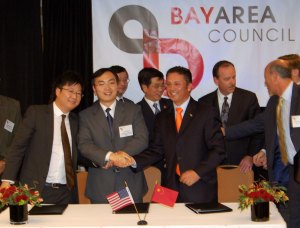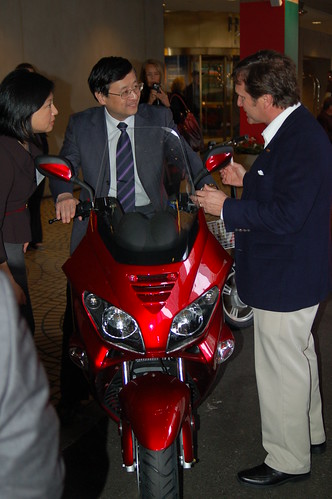Editorial: State can’t unlink its future from China’s
This editorial appeared in the Sacramento Bee in December, but we reprint it here to offer insight into ZAP’s electric vehicle strategy in China over the past 13 years.
With all the irritations between the United States and China, it is worth noting some opportunities for “competitive cooperation.”

Representatives from Wells Fargo, Deloitte & Touche, and the Bay Area Council helped dedicate the MOU signing between ZAP, Jonway and Yangup.
The latest agreements signed this month between the United States and Chinashould make U.S. businesses more competitive in selling everything from industrial machinery and telecom devices to equipment for large-scale wind farms.
California, particularly, is poised in coming years to benefit from the exchange – if we can get past the usual China-bashing that is a staple of the election campaign season.
For example, companies that participate in the construction of wind farms will now be able to participate in projects to install wind farms in China. Until now, they were not able to participate because their non-Chinese experience could not be used for qualification as a bidder on a China-based project. The new commitment by China will allow those companies to gain access.
California companies with wind farm construction experience could benefit from this new commitment by China.
And as Jennifer Turner of the Wilson Center has said, in many cases, combining the strengths of innovative U.S. technologies and Chinese manufacturing capacity can be an important driver of economic growth and jobs here and in China.
But we have to be looking for commonalities and opportunities. For example, California andChina are earthquake prone. China’s going to need to build 30,000 hospitals in the next 10 years. California has a lot of health care companies and a lot of experience building hospitals to meet earthquake standards. That is an exportable skill set.
The power, transportation, water and building materials sectors look particularly promising forCalifornia in forging unusual cross-border partnerships with China.
Here is one small example. California has many of the leading companies and innovators in the electric-vehicle industry.
Santa Rosa-based ZAP Electric Vehiclesannounced an agreement during Gov. Arnold Schwarzenegger’s September trade mission toChina whereby new plug-in vehicle technologies designed in California, combined with China-based manufacturing, will allow ZAP to provide electric charging stations, battery swap-out stations, as well as electric vehicle maintenance and repair depots in Shanghai’s Yangpu District.
Irvine-based Fisker Automotive has signed an agreement with a Chinese retailer to sell its sports luxury plug-in hybrid cars at 200 outlets in China.
Of the five biggest solar plants in China,infrastructure (such as polysilicon production equipment, crystalline ingot growth systems and fusion furnaces) comes from the United States, creating jobs here. Certainly, manufacturing solar panels in China creates jobs in China. But jobs also are created here at the project location.
Consider wind turbines. Designed here. Some components manufactured here, some in China.Assembled in China. Pylons built here. Installation here. Power generation here. Both sides get jobs.
The picture is much more complex than the “shipping jobs to China” slogan we hear every election season. If we embrace the concept of “cooperative competition” – even as we continue as a nation to seek enforceable agreements against pirating, protectionism and manipulated currency in China – we can take advantage of our strengths to make economic progress during this time of difficult economic transition.
Read more: http://www.sacbee.com/2010/12/27/3282500/state-cant-unlink-its-future-from.html#ixzz1A5OQl2Yz

